![]()
![]()
![]()
Use LEFT and RIGHT arrow keys to navigate between flashcards;
Use UP and DOWN arrow keys to flip the card;
H to show hint;
A reads text to speech;
47 Cards in this Set
- Front
- Back
|
Transition metals |
Sc, Ti, V, Cr, Mn, Fe, Co, Ni, Cu, Zn |
|
|
Oxidation states |

|
|
|
Paramagnetic |
Unpaired electrons |
|
|
Diamegnetic |
Paired electrons |
|
|
Repersentive |
Main group, transition, non-transition |
|
|
The transition metal rules |
The 3d orbital begins to fill after the 4S orbital is complet |
|
|
For complex ions |
The 4s will loose electrons first then the 3d |
|
|
Across the periodic table trends |
Atomic size decreases at first then remains constant Electro negativity and the ionization energies also increase |
|
|
Within a group |
The atomic size increases from 4-5 but not 5-6 |
|
|
Metallic behavior |
The lower the oxidation state of the transition metal, the more metallic its behavior |
|
|
Ionic bonding |
Is more prevalent for the lower oxidation states, wheres covalent bonding occurs more frequently for higher oxidation state |
|
|
Metals oxides become |
Less basic (more acidic) as the oxidation state increases |
|
|
A metal atom in a positive oxidation state |
Has a greater attraction for bonded electrons = a greater effective electronegativity or valance - state electronegativity, then in the zero oxidation state |
|
|
Color |
Preamegnetic =color bc its unpaired electrons |
|
|
Coordination number |
The number of atoms or ions immediately surrounding a central atom in a complex or crystal The number of bonds formed be a metal ions to ligand in complex ion varies form 2 to 8 or 4 to 6 bonds |
|
|
Coordination number 2 |
Linear |
|
|
Coordination number 4 |
Square planer or tetrahedral (depends on the the charge) |
|
|
Coordination number 6 |
Octahedral |
|
|
Types of ligands |
Monodentate: one bond to a metal Bidentate: two bonds to a metal Polydentate: more than two bonds to a metal |
|
|
Naming coordination [CO(NH3)5Cl]Cl2 |
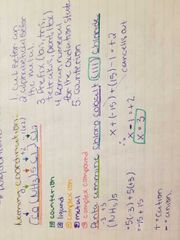
|
|
|
Coordination compoud |
Consist of a complex ion and a counter ion |
|
|
Parts of a complex compound |
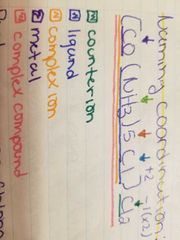
|
|
|
Metal- ligand bonding is entirely ionic |
Strong-feild (low spin) large splitting of d orbital Weak -feild (high spin) small splitting of d orbital |
|
|
When the geometry and the ligands are held constant, this splitting decreases in the following order |
Pt4+>Ir3+>Rh3+>CO3+>Cr3+>Fe2+>CO2+>Ni2+>Mn2+ |
|
|
Low spin |
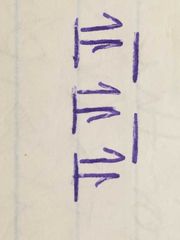
Diamegnetic = no color |
|
|
High spin |
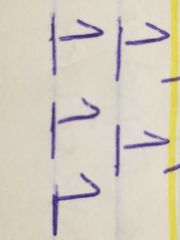
Paramagnetic --> Huns rule = color |
|
|
When the geometry and the metal are held constant, the splitting of the d orbitals increases in the following order |
I<Br<[NCS]<Cl<F<OH<H2O<NH3<en<CN<CO |
|
|
Strong ligand |
Not hunds = big ^E |
|
|
^E= hc/~ |
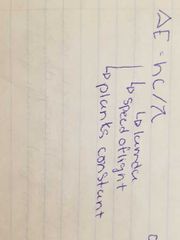
|
|
|
Square planer complex |
Rh(I) Ir(I) Pd(II) Pt(II) Au(III) |
|
|
The ways color can change |
Metal charge Ligand |
|
|
Red |
Absorbance 700-620 We see Green |
|
|
Orange |
Absorbance 620-580 We see blue |
|
|
Yellow |
Absorbance 580-560 We see purple |
|
|
Green |
Absorbance 560-490 We see Red |
|
|
Blue |
Absorbance 490-430 We see orange |
|
|
Purple |
Absorbance 430-380 We see yellow |
|
|
CFT |
Symmetry of ligands around a central metal/ion and how this anisotropic |
|
|
The d orbital split into two levels |
Eg ( two upper levels) and t2g (3 lower levels) For octahedral the energies are higher (0.6^°) while t2g is lower (0.4^°) |
|
|
Tetrahedral splitting constant (^t), which is less than (^°) for the same ligand |
Normally high spin ^t= 0.44^° |
|
|
The splitting energy (from highest to lowest orbital) is ^sp and tends to be larger then ^° |
^sp = 1.74 ^° |
|
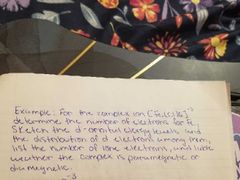
|
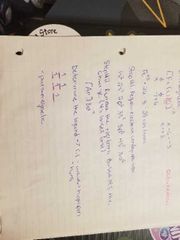
|
|
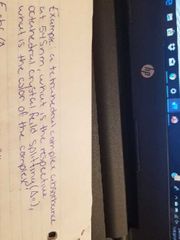
|

|
|
|
d10 electrons |
Colorless |
|
|
Anionic ligands |
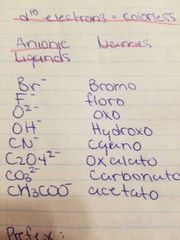
|
|
|
Neutral Ligands |
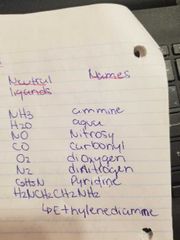
|
|
|
Prefex |
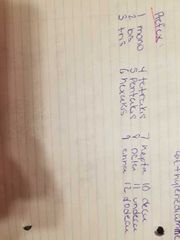
|

